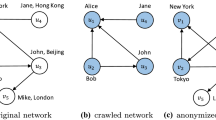Abstract
To protect users’ privacy, online social network data are usually anonymized before being sold to or shared with third parities. Various structure-based approaches have been proposed to de-anonymize the social network data. In this paper, we study the limitations of the existing structure-based de-anonymization methods and propose an enhanced de-anonymization algorithm. The basic idea of our algorithm is to leverage the structural transformations of the social graph to de-anonymize the social network data. We also define a new similarity measure that is more robust for de-anonymization. We use the arXiv dataset to evaluate our algorithm, and the experiment results show that our method can significantly improve the de-anonymization rate.
Access this chapter
Tax calculation will be finalised at checkout
Purchases are for personal use only
Similar content being viewed by others
References
Alexa: Top 500 global sites (2016). http://www.alexa.com/topsites. Accessed 2016
arXiv: arxiv bibiography (2016). http://arxiv.org/help/api/index. Accessed 2016
Backstrom, L., Dwork, C., Kleinberg, J.: Wherefore art thou r3579x?: anonymized social networks, hidden patterns, and structural steganography. In: Proceedings of the 16th International Conference on World Wide Web. pp. 181–190. ACM (2007)
Bhagat, S., Cormode, G., Krishnamurthy, B., Srivastava, D.: Class-based graph anonymization for social network data. Proc. VLDB Endowment 2(1), 766–777 (2009)
Deng, D., Du, H., Jia, X., Ye, Q.: Minimum-cost information dissemination in social networks. In: Xu, K., Zhu, H. (eds.) WASA 2015. LNCS, vol. 9204, pp. 83–93. Springer, Heidelberg (2015)
Ding, X., Zhang, L., Wan, Z., Gu, M.: A brief survey on de-anonymization attacks in online social networks. In: 2010 International Conference on Computational Aspects of Social Networks (CASoN). pp. 611–615. IEEE (2010)
Eagle, N., Pentland, A.: Reality mining: sensing complex social systems. Per. Ubiquit. Comput. 10(4), 255–268 (2006)
Ji, S., Li, W., Gong, N.Z., Mittal, P., Beyah, R.A.: On your social network de-anonymizablity: quantification and large scale evaluation with seed knowledge. In: The 2015 Network and Distributed System Security (NDSS) (2015)
Ji, S., Li, W., Srivatsa, M., He, J.S., Beyah, R.: Structure based data de-anonymization of social networks and mobility traces. In: Chow, S.S.M., Camenisch, J., Hui, L.C.K., Yiu, S.M. (eds.) ISC 2014. LNCS, vol. 8783, pp. 237–254. Springer, Heidelberg (2014)
Narayanan, A., Shmatikov, V.: De-anonymizing social networks. In: 30th IEEE Symposium on Security and Privacy, 2009, pp. 173–187. IEEE (2009)
Nilizadeh, S., Kapadia, A., Ahn, Y.Y.: Community-enhanced de-anonymization of online social networks. In: Proceedings of the 2014 ACM SIGSAC Conference on Computer and Communications Security. pp. 537–548. ACM (2014)
ONeill, N.: Senate begins discussing privacy implications of online advertising (2008). http://tinyurl.com/5aqqhe. Accessed 2008
Richardson, M., Domingos, P.: Mining knowledge-sharing sites for viral marketing. In: Proceedings of the Eighth ACM SIGKDD International Conference on Knowledge Discovery and Data Mining. pp. 61–70. ACM (2002)
Rohan, T., Tunguz-Zawislak, T.J., Sheffer, S.G., Harmsen, J.: Network node ad targeting, May 2013. uS Patent 8,438,062
Srivatsa, M., Hicks, M.: Deanonymizing mobility traces: using social network as a side-channel. In: Proceedings of the 2012 ACM Conference on Computer and Communications Security. pp. 628–637. ACM (2012)
Wang, Y., Cai, Z., Yin, G., Gao, Y., Tong, X., Wu, G.: An incentive mechanism with privacy protection in mobile crowdsourcing systems. Comput. Netw. 102, 157–171 (2016)
Wondracek, G., Holz, T., Kirda, E., Kruegel, C.: A practical attack to de-anonymize social network users. In: IEEE Symposium on Security and Privacy 2010 (IEEE SP). pp. 223–238. IEEE (2010)
Zhang, L., Cai, Z., Wang, X.: Fakeit: privately releasing user context streams for personalized mobile applications. In: IEEE Transactions on Network and Service Management (2016)
Zhang, L., Wang, X., Lu, J., Li, P., Cai, Z.: An efficient privacy preserving data aggregation approach for mobile sensing. Secur. Commun. Netw. J. 11, 980–992 (2016)
Zheleva, E., Getoor, L.: Preserving the privacy of sensitive relationships in graph data. In: Bonchi, F., Malin, B., Saygın, Y. (eds.) PInKDD 2007. LNCS, vol. 4890, pp. 153–171. Springer, Heidelberg (2008)
Zhou, B., Pei, J., Luk, W.: A brief survey on anonymization techniques for privacy preserving publishing of social network data. ACM Sigkdd Explor. Newslett. 10(2), 12–22 (2008)
Acknowledgment
This work was supported by the National Natural Science Foundation of China (Grant No. 61472418), the National Defense Basic Research Program of China (Grant No. JCKY2016602B001), the “Strategic Priority Research Program” of the Chinese Academy of Sciences (Grant No. XDA06040100), and the National Defense Science and Technology Innovation Fund, CAS (No. CXJJ-16-M118).
Author information
Authors and Affiliations
Corresponding author
Editor information
Editors and Affiliations
Rights and permissions
Copyright information
© 2016 Springer International Publishing Switzerland
About this paper
Cite this paper
Li, H., Zhang, C., He, Y., Cheng, X., Liu, Y., Sun, L. (2016). An Enhanced Structure-Based De-anonymization of Online Social Networks. In: Yang, Q., Yu, W., Challal, Y. (eds) Wireless Algorithms, Systems, and Applications. WASA 2016. Lecture Notes in Computer Science(), vol 9798. Springer, Cham. https://doi.org/10.1007/978-3-319-42836-9_30
Download citation
DOI: https://doi.org/10.1007/978-3-319-42836-9_30
Published:
Publisher Name: Springer, Cham
Print ISBN: 978-3-319-42835-2
Online ISBN: 978-3-319-42836-9
eBook Packages: Computer ScienceComputer Science (R0)




